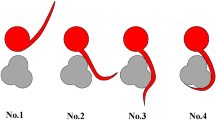Abstract
In this paper, we propose a multi-legged robot that is designed for operating on rubble. Generally, conventional multi-legged robots have many actuators for driving the legs and body. Hence, control in the case of these robots is more complicated than that in the case of crawler robots, and it is very difficult to operate multi-legged robots adaptively in a complex environment like rubble. To solve this problem, we have designed a mechanism of the legged robot for reducing the controller load by utilizing a passive mechanism. To design the robot, we focus on a centipede. First, we observe the behavior of a centipede using a high-speed camera, and then, to realize this behavior by a simple mechanism, we propose a multi-legged robot that is realized by connecting many links serially through rubber joints. In this mechanism, every joint has a leg on both sides, and the robot moves regularly like a centipede. The elasticity of the rubber joints compensates for the bumps on the ground. To control the moving direction, wires are installed through the links, and by pulling the wires, the body of the robot can be lifted up or turned. By simply pulling the suitable wires, we can control the moving direction of the robot. We do not have to control many joints individually for crossing bumps. They can move passively and can cross the bumps. To demonstrate the effectiveness of the proposed robot, we have developed a prototype robot and conducted certain experiments. The results show that the robot can move on rubble to desired positions.











Similar content being viewed by others
Explore related subjects
Discover the latest articles and news from researchers in related subjects, suggested using machine learning.References
Arai M, Takayama T, Hirose S (2004) Development of Souryu-III: connected crawler vehicle for inspection inside narrow and winding spaces. In: Proceedings of IEEE/RSJ international conference on intelligent robots and system, Vol. 1, pp 52–57
Tanaka J, Suzumori K, Tanaka M, Kanada T, Mori M (2005) A mobile jack robot for rescue operation. In: Proceedings of IEEE international workshop on safety, security and rescue robotics, pp 99–104
Haraguchi R, Osuka K, Makita S, Tadokoro S (2005) The development of the mobile inspection robot for rescue activity, MOIRA2. In: Proceedings of 12th international confence on advanced robotics, pp 498–505
Miyanaka H, Wada N, Kamegawa T, Sato N, Tsukui S, Igarashi H, Matsuno F (2007) Development of an unit type robot [KOHGA2] with stuck avoidance ability. In: Proceedings of IEEE international conference on robotics and automation, pp 3877–3882
Rohmer E, Ohno K, Yoshida T, Nagatani K, Konayagi E, Tadokoro D (2010) Integration of a sub-crawlers’autonomous control in quince highly mobile rescue robot. In: Proceedings of IEEE/SICE international symposium on system integration, pp 78–83
Maruyama H, Ito K (2010) Semi-autonomous snake-like robot for search and rescue. In: Proceedings of 8th IEEE international workshop on safety, security, and rescue robotics, pp 1–6
Torige A, Noguchi M, Ishizawa N (1993) Centipede type multi-legged walking robot. In: Proceedings of the IEEE/RSJ international conference on intelligent robots and systems, pp 567–571
Inagaki S, Niwa T, Suzuki T (2010) Follow-the-contact-point gait control of centipede-like multi-legged robot to navigate and walk on uneven terrain. In: The IEEE/RSJ international conference on intelligent robots and systems, pp 5341–5346
Kito Y, Sueoka Y, Nakanishi D, Sugimoto Y, Ishikawa M, Osuka K, (2014) Design of multi-layered spine unit with 3DoF flexibility. ROBOMECA 2014, (2A1-I07)
Acknowledgments
This study was partially supported by the Ministry of Education, Culture, Sports, Science and Technology (MEXT) through a Grant-in-Aid for Young Scientists (B) (22700156, 2011).
Author information
Authors and Affiliations
Corresponding author
About this article
Cite this article
Ito, K., Kashiwada, S. Proposal of semiautonomous centipede-like robot for rubbles. Artif Life Robotics 19, 400–405 (2014). https://doi.org/10.1007/s10015-014-0181-x
Received:
Accepted:
Published:
Issue Date:
DOI: https://doi.org/10.1007/s10015-014-0181-x




